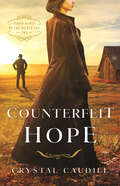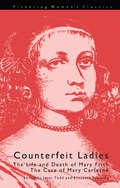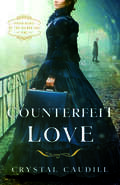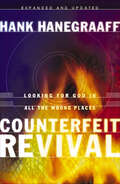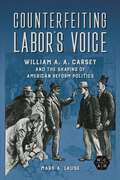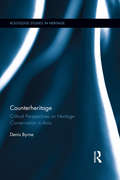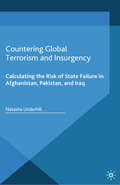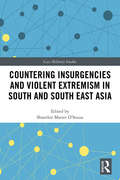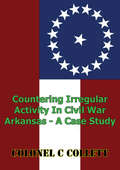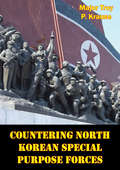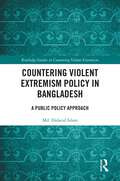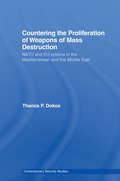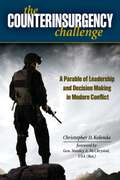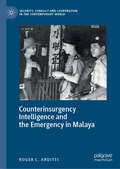- Table View
- List View
Counterfeit Hope (Hidden Hearts of the Gilded Age #2)
by Crystal CaudillTrapped by their pasts, is there hope for a future?When Secret Service operative Andrew Darlington is brought in to support a US Marshal case involving counterfeiters in rural Indiana, he thinks it's simply the next rung on his climb to the top of his career. But liars can only climb so high--and Andrew is keeping a dangerous secret he doesn't ever want to get out. When he clashes with the criminal family that took over the town of Landkreis and killed the Marshal he was sent to assist, his past life is in danger of being exposed.Widow "Lightning Lu" Thorne has only one goal: escape the clutches of the Thorne family with her son. Her decision to be an informant and testify against the Thornes looked like the perfect answer. Until the Marshal ended up dead. Now the tether keeping her tied to her felonious family is tightening, and a forced marriage to someone else in the Thornes' clutches threatens to kill any hope of escape.Andrew and Lu find themselves on the same team--unwillingly. They each believe the other to be the enemy to their future plans. And even if they could learn to work together, the secrets they hold could shatter all hopes and dreams. Despite the encouragement of the local preacher, they're not even sure God can be trusted--much less other humans. Can either of them escape their past--and the family that is willing to kill their own when they smell betrayal?On the heels of her smashing debut, this second entry in Crystal Caudill's historical series maintains the excitement that readers of Michelle Griep, Liz Tolsma, and Elizabeth Camden will love.
Counterfeit Justice: The Judicial Odyssey of Texas Freedwoman Azeline Hearne (Conflicting Worlds: New Dimensions of the American Civil War)
by Dale BaumFor many of the forty years of her life as a slave, Azeline Hearne cohabitated with her wealthy, unmarried master, Samuel R. Hearne. She bore him four children, only one of whom survived past early childhood. When Sam died shortly after the Civil War ended, he publicly acknowledged his relationship with Azeline and bequeathed his entire estate to their twenty-year-old mulatto son, with the provision that he take care of his mother. When their son died early in 1868, Azeline inherited one of the most profitable cotton plantations in Texas and became one of the wealthiest ex-slaves in the former Confederacy. In Counterfeit Justice, Dale Baum traces Azeline's remarkable story, detailing her ongoing legal battles to claim and maintain her legacy.As Baum shows, Azeline's inheritance quickly made her a target for predatory whites determined to strip her of her land. A familiar figure at the Robertson County District Court from the late 1860s to the early 1880s, Azeline faced numerous lawsuits -- including one filed against her by her own lawyer. Samuel Hearne's family took steps to dispossess her, and other unscrupulous white men challenged the title to her plantation, using claims based on old Spanish land grants. Azeline's prolonged and courageous defense of her rightful title brought her a certain notoriety: the first freedwoman to be a party to three separate civil lawsuits appealed all the way to the Texas Supreme Court and the first former slave in Robertson County indicted on criminal charges of perjury. Although repeatedly blocked and frustrated by the convolutions of the legal system, she evolved from a bewildered defendant to a determined plaintiff who, in one extraordinary lawsuit, came tantalizingly close to achieving revenge against those who defrauded her for over a decade. Due to gaps in the available historical record and the unreliability of secondary accounts based on local Reconstruction folklore, many of the details of Azeline's story are lost to history. But Baum grounds his speculation about her life in recent scholarship on the Reconstruction era, and he puts his findings in context in the history of Robertson County. Although history has not credited Azeline Hearne with influencing the course of the law, the story of her uniquely difficult position after the Civil War gives an unprecedented view of the era and of one solitary woman's attempt to negotiate its social and legal complexities in her struggle to find justice.Baum's meticulously researched narrative will be of keen interest to legal scholars and to all those interested in the plight of freed slaves during this era.
Counterfeit Ladies: The Life and Death of Moll Cutpurse and the Case of Mary Carleton (Pickering Women's Classics)
by Elizabeth SpearingBiographies of two 17th-century female criminals, both celebrated in their day. These are the first editions published since the 17th century.
Counterfeit Lady
by Jude DeverauxReturn to the New York Times bestselling Jude Deveraux&’s James River series with this passionate, enchanting, and breathtaking romance classic!Nicole Courtalain—a passionate French beauty—finds herself the victim of a case of mistaken identity when she is kidnapped by mistake and swept across turbulent seas to eighteenth century Virginia. There, she discovers the lush lands, rolling rivers, and astonishing plantations—and Clayton Armstrong, who awaited his English bride. What does their future have in store for them now that fate has changed their plans forever?
Counterfeit Love (Hidden Hearts of the Guilded Age)
by Crystal CaudillCan this undercover agent save the woman he loves--or is her heart as counterfeit as the money he's been sent to track down?After all that Grandfather has sacrificed to raise her, Theresa Plane owes it to him to save the family name--and that means clearing their debt with creditors before she marries Edward Greystone. But when one of the creditors' threats leads her to stumble across a midnight meeting, she discovers that the money he owes isn't all Grandfather was hiding. And the secrets he kept have now trapped Theresa in a life-threatening fight for her home--and the truth.After months of undercover work, Secret Service operative Broderick Cosgrove is finally about to uncover the identity of the leader of a notorious counterfeiting ring. That moment of triumph turns to horror, however, when he finds undeniable proof that his former fiancée is connected. Can he really believe the woman he loved is a willing participant? Protecting Theresa and proving her innocence may destroy his career--but that's better than failing her twice in one lifetime.They must form a partnership, tentative though it is. But there's no question they're both still keeping secrets--and that lack of trust, along with the dangerous criminals out for their blood, threatens their hearts, their faith, and their very survival.Combining rich history, danger, suspense, and romance, Crystal Caudill's debut novel launches this new historical series with a bang. Fans of Elizabeth Camden, Michelle Griep, and Joanna Davidson Politano will be thrilled to find another author to follow!
Counterfeit Revival: Looking For God in All the Wrong Places
by Hank HanegraaffHank Hanegraaff documents the danger of looking for God in all the wrong places and goes behind the scenes into the wildly popular and bizarre world of contemporary revivalism. Hanegraaff masterfully exposes the stark contrast between these deeds of the flesh and a genuine work of the Spirit by contrasting modern "revivals" with the scriptural examples of God's movement among His people.
Counterfeit Worlds: The Cinematic Universes of Philip K. Dick
by Brian J. RobbDive into the worlds of Philip K. Dick who inspired some of the most famous sci-fi movies of all time! Philip K. Dick struggled to make a living during his lifetime, but his work has since served as a deep seam of ideas to be mined by filmmakers such as Ridley Scott, Paul Verhoeven, Steven Spielberg, John Woo and Richard Linklater, resulting in some of the most successful and influential SF movies of all time. For the still-unequalled future world of Blade Runner to the mind-bending A Scanner Darkly, via the blockbusting action/adventure of Total Recall, Paycheck and Minority Report – not to mention the debt of gratitude films like The Matrix and The Truman Show owe to his work – the legacy of Philip K. Dick has revolutionised Hollywood.
Counterfeiter: How a Norwegian Jew Survived the Holocaust
by Moritz Nachtstern Ragnar ArntzenThis is an enthralling personal account of the secret Nazi project, Operation Bernhard, devised to destabilize the British and, later, American economies by creating and putting into circulation millions of counterfeit banknotes.
Counterfeiting Labor's Voice: William A. A. Carsey and the Shaping of American Reform Politics (Working Class in American History)
by Mark A. LauseConfidence man and canny operative, charlatan and manipulator--William A. A. Carsey emerged from the shadow of Tammany Hall to build a career undermining working-class political organizations on behalf of the Democratic Party. Mark A. Lause’s biography of Carsey takes readers inside the bare-knuckle era of Gilded Age politics. An astroturfing trailblazer and master of dirty tricks, Carsey fit perfectly into a Democratic Party that based much of its post-Civil War revival on shattering third parties and gathering up the pieces. Lause provides an in-depth look at Carsey’s tactics and successes against the backdrop of enormous changes in political life. As Carsey used a carefully crafted public persona to burrow into unsuspecting organizations, the forces he represented worked to create a political system that turned voters into disengaged civic consumers and cemented America’s ever-fractious two-party system.
Counterheritage: Critical Perspectives on Heritage Conservation in Asia
by Denis ByrneThe claim that heritage practice in Asia is Eurocentric may be well-founded, but the view that local people in Asia need to be educated by heritage practitioners and governments to properly conserve their heritage distracts from the responsibility of educating oneself about the local-popular beliefs and practices which constitute the bedrock of most people’s engagement with the material past. Written by an archaeologist who has long had one foot in the field of heritage practice and another in the academic camp of archaeology and heritage studies, Counterheritage is at once a forthright critique of current heritage practice in the Asian arena and a contribution to this project of self-education. Popular religion in Asia – including popular Buddhism and Islam, folk Catholicism, and Chinese deity cults – has a constituency that accounts for a majority of Asia’s population, making its exclusion from heritage processes an issue of social justice, but more pragmatically it explains why many heritage conservation programs fail to gain local traction. This book describes how the tenets of popular religion affect building and renovation practices and describes how modernist attempts to suppress popular religion in Asia in the early and mid-twentieth century impacted religious ‘heritage.’ Author Denis Byrne argues that the campaign by archaeologists and heritage professionals against the private collecting and ‘looting’ of antiquities in Asia largely ignores the regimes of value which heritage discourse has helped erect and into which collectors and local diggers play. Focussing on the Philippines, Thailand, and Taiwan but also referencing China and other parts of Southeast Asia, richly detailed portraits are provided of the way people live with ‘old things’ and are affected by them. Narratives of the author’s fieldwork are woven into arguments built upon an extensive and penetrating reading of the historical and anthropological literature. The critical stance embodied in the title ‘counterheritage’ is balanced by the optimism of the book’s vision of a different practice of heritage, advocating a view of heritage objects as vibrant, agentic things enfolded in social practice rather than as inert and passive surfaces subject to conservation.
Countering Colonization: Native American Women and Great Lakes Missions, 1630-1900
by Carol DevensThis title is part of UC Press's Voices Revived program, which commemorates University of California Press’s mission to seek out and cultivate the brightest minds and give them voice, reach, and impact. Drawing on a backlist dating to 1893, Voices Revived makes high-quality, peer-reviewed scholarship accessible once again using print-on-demand technology. This title was originally published in 1992.
Countering Global Terrorism and Insurgency: Calculating The Risk Of State-failure In Afghanistan, Pakistan And Iraq (New Security Challenges)
by Natasha UnderhillExplores current debates around religious extremism as a means to understand and re-think the connections between terrorism, insurgency and state failure. Using case studies of Pakistan, Afghanistan and Iraq, she develops a better understanding of the underlying causes and conditions necessary for terrorism and insurgency to occur.
Countering Hitler's Spies: British Military Intelligence, 1940–1945
by Stephen WynnThis WWII espionage history reveals how a British counterintelligence program turned Nazi spies into valuable double agents.Far from the battlefields of the Second World War, a secret conflict of intelligence and counterintelligence was being waged. As German spies infiltrated the United Kingdom, they were captured by MI5—and offered a deal. Through the Double Cross System, they could turn on their own country and spy for the British. The Double Cross System and the spies it produced saved thousands of Allied lives. They even contributed to the success of the D-Day landings at Normandy. Double agents helped convince Nazi Germany that the Allied invasion of Europe would take place across the English Channel, at Calais. One double agent was so good at what he did that Germany awarded him the Iron Cross, whilst Britain made him a Member of the British Empire (MBE).
Countering Insurgencies and Violent Extremism in South and South East Asia (Cass Military Studies)
by Shanthie Mariet D'SouzaThis volume of case studies examines the rise in violent extremism, terrorism and insurgency in South and South East Asia, and subsequent state responses. The South and South East of Asia has experienced various forms of extremism and violence for years, with a growing demand for academic or policy-relevant work that will enhance understanding of the reasons behind this. The violent challenges in this area have taken a variety of forms and are often exacerbated by lack of governance, tie-ins to existing regional criminal networks, colonial legacies and a presence of international terrorist movements. Written by experts with field experience, this volume analyzes the key element of successful response as the appropriate application of doctrine following nuanced assessment of threat. In practice, this often means counterinsurgency doctrine. The essays also analyze the need for irregular war practitioners to systematically examine the changing character of intrastate violent irregular challenges. The volume fills a gap in the understanding of patterns, drivers, organizations and ideologies of various insurgent and terrorist groups, and state responses. It also provides a set of recommendations for addressing the unfolding situation. This book will be of much interest to students of terrorism and political violence, counterinsurgency and counterterrorism, Asian politics and security studies in general.
Countering Irregular Activity In Civil War Arkansas - A Case Study
by Colonel C. CollettCivil War Arkansas endured many forms of irregular or guerilla warfare including activity that approached insurgency. It was a complex arena that resembles the present day and it illustrates much of contemporary counterinsurgency doctrine.Arkansas was a Southern state with a significant Unionist population and this divide fueled and shaped much of the conflict. Arkansas was unique in that the Confederate commander seeking to make up for conventional weakness, initiated guerilla warfare directed at Union forces. In response, Union commanders who were merely to protect lines of communication responded with punitive actions against individuals and communities which did little to reduce guerilla activity and served to alienate the local population.As the war progressed, however, guerilla bands shifted from military targets becoming progressively more terrorist, criminal, and once a Unionist state government was installed, insurgent. The Union army's role also changed as the main war moved on from the Mississippi basin and Arkansas became an early field for Lincoln's plan to reincorporate rebel states. The army's emphasis thus shifted to extending Federal authority and its organization and tactics evolved into a successful combination of locally raised troops, intelligence led operations, isolation of the guerillas, and political reconciliation.
Countering Modernity: Communal and Cooperative Models from Indigenous Peoples
by Carolyn Smith-Morris César Abadía-BarreroThis volume highlights and examines how Indigenous Peoples continue to inhabit the world in counter-modern ways. It illustrates how communalist practices and cooperative priorities of many Indigenous communities are simultaneously key to their cultural survival while being most vulnerable to post-colonial erasure. Chapters contributed by community collectives, elders, lawyers, scholars, multi-generational collaboratives, and others are brought together to highlight the communal and cooperative strategies that counter the modernizing tropes of capitalist, industrialist, and representational hegemonies. Furthermore, the authors of the book explicitly interrogate the roles of witness, collaborator, advocate, and community leader as they consider ethical relations in contexts of financialized global markets, ongoing land grabbing and displacement, epistemic violence, and post-colonial erasures.Lucid and topical, the book will be indispensable for students and scholars of anthropology, modernity, capitalism, history, sociology, human rights, minority studies, Indigenous studies, Asian studies, and Latin American studies.
Countering North Korean Special Purpose Forces
by Major Troy P. KrauseAs United States and Republic of Korea forces stand to defend against a DPRK attack, one of the most formidable tasks is how to counter a second front in the Joint Rear Security Area of the Republic of Korea.North Korea has a robust and diverse special operations force capability, their 'Special Purpose Forces.' With nearly 104,000 soldiers committed to these daring tactics and operations, the United States and the Republic of Korea must be vigilant and innovative to protect their forces from such attacks.The principal mission of the North Korean Special Purpose Forces is to infiltrate into the enemies rear area and conduct short duration raids. Their most dangerous avenue of approach for their forces includes amphibious approaches, airborne infiltration and the use of a vast tunnel network. How would the North carry out such an attack against such formidable foes? Will they use special operation's type forces to disrupt the South in their rear areas? How would they move their forces into South Korea? What solutions does the United States and the Republic of Korea have to solve this problem and which one is the best?This analysis examines the various methods the United States and the Republic of Korea will use to counter the North Korean Special Purpose Forces today and in the future.
Countering Terrorism and WMD: Creating a Global Counter-Terrorism Network (Political Violence)
by Peter Katona Michael D. Intriligator John P. SullivanThis volume shows us that in order to deal with today’s Fourth Generation asymmetric warfare by terrorist groups using conventional arms and weapons of mass destruction, we need a new ‘global networked’ approach. The contributors examine the various attempts that have been made to counter the latest wave of terrorism, including the US strikes against Afghanistan and Iraq, President George W. Bush's declaration of a ‘war against terrorism’, the creation of the US Department of Homeland Security, and the 9/11 Commission. Drawing from our experience with ‘Terrorism Early Warning’ and the co-production of counter-terrorism intelligence, this book explains the need for such a network and shows how it could be formed. It compiles the opinions of experts from clinical medicine, public policy, law enforcement and the military. These expert contributors identify the nature of a global counter-terrorism network, show how it could be created, and provide clear guidelines for gauging its future effectiveness. This book will be of great interest to all students of terrorism studies, US national security, international relations, and political science in general.
Countering Violent Extremism Policy in Bangladesh: A Public Policy Approach (Routledge Studies in Countering Violent Extremism)
by Md. Didarul IslamThis book investigates how Bangladesh formulates its Countering Violent Extremism (CVE) policy as a norm-receiving country.Norm-producing institutions and countries, such as the United Nations, the European Union, the UK, Australia, and Saudi Arabia, have diffused CVE norms in numerous countries through various mechanisms. Consequently, countries such as Bangladesh, Nigeria, Greece, Kenya, and many others, who initiated CVE policy late, became norm receivers. Despite widespread adoption and criticism of CVE policies globally, Bangladesh has shifted from traditional counterterrorism to CVE. This book provides the first comprehensive account of CVE policy formulation in Bangladesh through policy actor interviews. It offers a public policy perspective, integrating three theoretical dimensions: drivers of public policy; ideology, learning, and policy diffusion; and localisation. Through interviews with CVE policymakers, the book navigates policy actors’ understanding of effective CVE practices, contributing factors, and the diffusion and localisation of external policies and norms in Bangladesh.This book will be of interest to students of CVE, counterterrorism, South Asian politics, and international relations.
Countering the Proliferation of Weapons of Mass Destruction: NATO and EU Options in the Mediterranean and the Middle East (Contemporary Security Studies)
by Thanos P DokosAs counter-profileration is expected to become the central element in the new national security policy of the US, such actions will constitute a central element of every major international conflict in the first decades of the 21st century. One of the most important geostrategic phenomena of the past decade has been the extraordinary diffusion of war-making capabilities from the developed North to the developing South. In the eyes of some proliferant states, possessing nuclear, biological and chemical (NBC) weapons would not only add to their regional stature, but would also offer an asymmetrical counter to the West’s massive superiority in conventional forces. In the Eastern Mediterranean and the Middle East, a number of countries are assumed to possess varying levels of NBC-weapons capabilities. Reasons for concern include the fact that such weapons have been used in the past; the region’s geographic proximity to Europe and the vital interests of the West (which is prepared, under certain circumstances, to use force to protect them); the multiplicity of conflicts and other security problems; and the general instability in the region (including the spread of religious extremism).This important and timely book assesses, in detail, the accuracy of predictions, and perceptions, about a possible military threat from the Southern Mediterranean (Muslim) world; and their impact on NATO’s political and military posture. Thanos P. Doxos presents an assessment of the Alliance’s options for dealing with the problem. This book represents an invaluable, topical resource for researchers and policy makers.
Countering the Proliferation of Weapons of Mass Destruction: NATO and EU Options in the Mediterranean and the Middle East (Contemporary Security Studies)
by Thanos P. DokosAs counter-profileration is expected to become the central element in the new national security policy of the US, such actions will constitute a central element of every major international conflict in the first decades of the 21st century. One of the most important geostrategic phenomena of the past decade has been the extraordinary diffusion of w
Counterinsurgency
by Douglas PorchCounterinsurgency has staked its claim in the new century as the new American way of war. Yet, the wars in Afghanistan and Iraq have revived a historical debate about the costs - monetary, political and moral - of operations designed to eliminate insurgents and build nations. Today's counterinsurgency proponents point to 'small wars' past to support their view that the enemy is 'biddable' if the correct tactical formulas are applied. Douglas Porch's sweeping history of counterinsurgency campaigns carried out by the three 'providential nations' of France, Britain and the United States, ranging from nineteenth-century colonial conquests to General Petraeus's 'Surge' in Iraq, challenges the contemporary mythologising of counterinsurgency as a humane way of war. The reality, he reveals, is that 'hearts and minds' has never been a recipe for lasting stability and that past counterinsurgency campaigns have succeeded not through state-building but by shattering and dividing societies while unsettling civil-military relations.
Counterinsurgency Challenge
by Christopher D. Kolenda Stanley A. McChrystalA journey through the mind of a commander as he learns and adapts in a complex, deadly environment.
Counterinsurgency Field Manual
by The U.S. Army Marine CorpsWhen the U.S. military invaded Iraq, it lacked a common understanding of the problems inherent in counterinsurgency campaigns. It had neither studied them, nor developed doctrine and tactics to deal with them. It is fair to say that in 2003, most Army officers knew more about the U.S. Civil War than they did about counterinsurgency.The U.S. Army / Marine Corps Counterinsurgency Field Manual was written to fill that void. The result of unprecedented collaboration among top U.S. military experts, scholars, and practitioners in the field, the manual espouses an approach to combat that emphasizes constant adaptation and learning, the importance of decentralized decision-making, the need to understand local politics and customs, and the key role of intelligence in winning the support of the population. The manual also emphasizes the paradoxical and often counterintuitive nature of counterinsurgency operations: sometimes the more you protect your forces, the less secure you are; sometimes the more force you use, the less effective it is; sometimes doing nothing is the best reaction. An new introduction by Sarah Sewall, director of the Carr Center for Human Rights Policy at Harvard’s Kennedy School of Government, places the manual in critical and historical perspective, explaining the significance and potential impact of this revolutionary challenge to conventional U.S. military doctrine. An attempt by our military to redefine itself in the aftermath of 9/11 and the new world of international terrorism, The U.S. Army / Marine Corps Counterinsurgency Field Manual will play a vital role in American military campaigns for years to come. The University of Chicago Press will donate a portion of the proceeds from this book to the Fisher House Foundation, a private-public partnership that supports the families of America’s injured servicemen. To learn more about the Fisher House Foundation, visit www.fisherhouse.org.
Counterinsurgency Intelligence and the Emergency in Malaya (Security, Conflict and Cooperation in the Contemporary World)
by Roger C. ArdittiThis book examines the full range of counterinsurgency intelligence during the Malayan Emergency. It explores the involvement of the Security Service, the Joint Intelligence Committee (Far East), the Malayan Security Service, Special Branch and wider police service, and military intelligence, to examine how British and Malayan authorities tackled the insurgent challenge posed by the Malayan Communist Party. This study assesses the nature of the intelligence apparatus prior to the declaration of emergency in 1948 and considers how officials attempted to reconstruct the intelligence structures in the Far East after the surrender of the Japanese in 1945. These plans were largely based upon the legacy of the Second World War but quickly ran into difficultly because of ill-defined remits and personality clashes. Nevertheless, officials did provide prescient warning of the existential threat posed by the Malayan Communist Party from the earliest days of British reoccupation of Malaya. Once a state of emergency had been declared, officials struggled to find the right combination of methods, strategy and management structures to eliminate the threat posed by the Communist insurgents. This book argues that the development of an effective counterinsurgency intelligence strategy involved many more organisations than just Special Branch. It was a multifaceted, dynamic effort that took far longer and was more problematic than previous accounts suggest. The Emergency remains central to counterinsurgency theory and thus this wide-ranging analysis sheds crucial light not only on the period, but on contemporary doctrine and security practices today.
